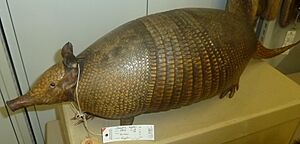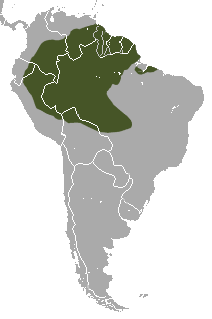Greater long-nosed armadillo facts for kids
Quick facts for kids Greater long-nosed armadillo |
|
|---|---|
 |
|
| Conservation status | |
| Scientific classification | |
| Genus: |
Dasypus
|
| Species: |
kappleri
|
 |
|
| Greater long-nosed armadillo range | |
The greater long-nosed armadillo (Dasypus kappleri) is a cool animal from South America. You can find it in countries like Colombia, Venezuela, Ecuador, Guyana, Suriname, French Guiana, Peru, Bolivia, and Brazil. This armadillo is a bit of a loner and mostly active at night. It lives on land and loves to eat small creatures like arthropods and other invertebrates. You'll often find it living close to streams and swamps.
This armadillo is one of the bigger kinds! It can be about 83 to 106 centimeters (33 to 42 inches) long from its nose to the tip of its tail. It usually weighs between 8.5 and 10.5 kilograms (19 to 23 pounds), but some can even reach 15 kilograms (33 pounds). It has special spurs on its back legs. These spurs help it crawl on its knees into tight tunnels, which is pretty neat!
Contents
Meet the Greater Long-Nosed Armadillo
The greater long-nosed armadillo is the biggest armadillo in its group. Its body, not including the tail, is usually between 51 and 57 centimeters (20 to 22 inches) long. Its tail adds another 32 to 48 centimeters (13 to 19 inches) to its length.
What Does It Look Like?
Like other armadillos, this one has a tough, bony shield protecting its front and back parts. In the middle, it has seven or eight bony rings that let it bend. A special thing about this armadillo is the rows of large scales that stick out on the back of its hind legs. These scales help it move around.
Where Does This Armadillo Live?
This armadillo calls the warm, wet parts of northeastern South America home. Its range includes countries like Guyana, Suriname, and French Guiana. It also lives in Colombia (east of the Andes mountains) and Venezuela (south of the Orinoco River). You can also find it in the Amazon Basin of Brazil, Ecuador, Peru, and northeastern Bolivia.
Its Favorite Places to Be
The greater long-nosed armadillo loves humid lowland forests, especially near the Orinoco and Amazon rivers. It can also be found in small patches of forest within grassy areas called savannahs. It's quite common in forest uplands where there's less hunting. It likes to search for food on floodplains near streams, in palm swamps, and on hillsides.
Armadillo Life and Habits
Scientists haven't studied this armadillo a lot, so we don't know everything about its life. However, the Matsés people, an indigenous tribe from the Amazon, have shared a lot of information about these animals. They know a lot because they live alongside them.
A Day in the Life of an Armadillo
This armadillo is a solitary animal, meaning it likes to be alone. It's also nocturnal, which means it's active at night. During the day, it sleeps in a burrow. It digs these burrows in the banks of gullies or next to streams. Each burrow has one entrance, a cozy sleeping room lined with leaves, and a long tunnel. Sometimes, the tunnel might even have a little water in it. Each armadillo has several burrows and uses different ones on different days.
Interestingly, small white flies often live near these armadillos. You can see them at the entrance of active burrows during the day. There are more flies when an armadillo is inside. The Matsés people hunt this armadillo for food. They really like its meat, especially in April and May when it's fattest. They often catch it by flooding its burrow and then digging it out. When this armadillo is bothered, it makes a rumbling growl. If it's attacked, it growls even louder!
Nighttime Adventures
As evening approaches, the armadillo starts to wake up. Once it's fully dark, it rushes out of its burrow. It then follows one of its usual paths, which go along hilltops and through areas where it looks for food. The armadillo stops often to search for beetles and their larvae, millipedes, and centipedes. It digs in soft ground to find earthworms and also eats fallen fruit. It especially loves the fruits of the Oenocarpus bataua palm tree. It also eats ants that climb on these fruits and any other small creatures it finds.
This armadillo isn't afraid of water! It might swim across streams and roll around in mud holes. When dawn comes, it finds its way back to one of its burrows. It gathers some leaf litter to add to its bed and goes underground. It moves around, making its bed comfy before settling down. Sometimes, it might even come out during the day if it's raining heavily.
Family Life and Dangers
Mating might happen when two armadillos meet at night. The female usually has two babies, which are born in the burrow. Once they are old enough, the young armadillos follow their mother around.
When the armadillo is out at night, big cats like jaguars (Panthera onca) and pumas (Puma concolor) are the biggest dangers. If it swims across streams, a black caiman (Melanosuchus niger) or an anaconda (Eunectes murinus) might try to catch it. Groups of tayras (Eira barbara), which are like large weasels, can also kill armadillos. During the day, bush dogs (Speothos venaticus) sometimes go into the burrow and pull the armadillo out, eating it right by the entrance.
Conservation Status
The greater long-nosed armadillo has a very wide range and lives in many protected areas. The main threat it faces is deforestation, which is when forests are cut down. This is because it cannot live in open areas without trees. People hunt it for meat in some places, but no other major threats have been found. The International Union for Conservation of Nature says its conservation status is "least concern". This means it's not currently in danger of disappearing. In the Llanos region of Colombia, an organization called Fundación Omacha is working to teach local people about this armadillo and how important it is.


